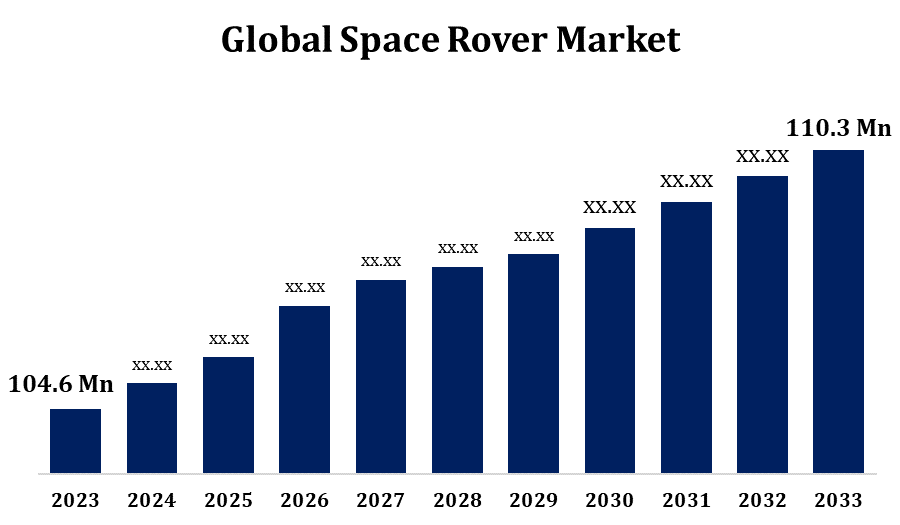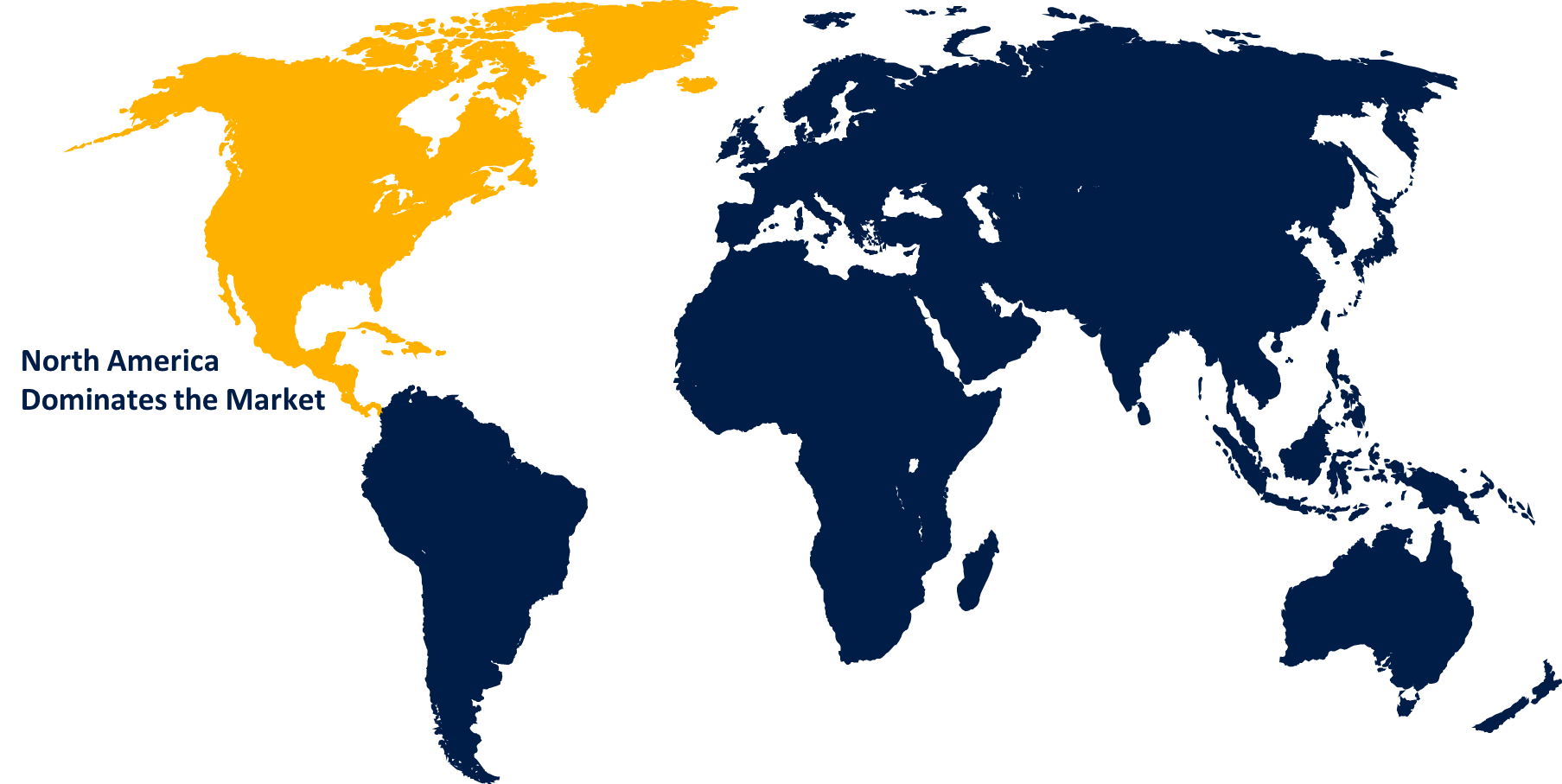Global Space Rover Market Size By Application (Lunar Surface, Mars Surface, and Asteroids Surface), By Solution (Hardware and Software), By Region, And Segment Forecasts, By Geographic Scope And Forecast to 2033
Industry: Aerospace & DefenseGlobal Space Rover Market Insights Forecasts to 2033
- The Global Space Rover Market Size was valued at USD 104.6 Million in 2023.
- The Market Size is growing at a CAGR of 0.53% from 2023 to 2033
- The Worldwide Space Rover Market Size is expected to reach USD 110.3 Million by 2033
- Asia Pacific Market is expected to grow the fastest during the forecast period

Get more details on this report -
The Global Space Rover Market Size is expected to reach USD 110.3 Million by 2033, at a CAGR of 0.53% during the forecast period 2023 to 2033.
The design, production, testing, and deployment of robotic vehicles intended to investigate extraterrestrial conditions are all included in the space rover market. To explore and explore the surfaces of planets, these vehicles are outfitted with scientific tools, cameras, sensors, movement systems, and communication devices. On exploration missions, space rovers are used to carry out experiments, collect data, and carry out scientific study in order to learn more about the climate, geology, atmosphere, and possibility of habitability of other planets and moons. Studying surface features, looking for traces of past or current life, and examining soil or rock samples are a few examples of mission objectives. The market for space rovers is attracting increasing interest from businesses in addition to government-led initiatives. For the purpose of exploring the moon and finding resources, private businesses are creating their own rover technologies.
Space Rover Market Value Chain Analysis
Research and development (R&D) is done by academic institutions, governmental organisations, and commercial businesses to design and prototype space rover technologies. The main goals of R&D are to advance scientific instruments, autonomy, robotics, mobility systems, and other essential space rover components. Space rover design is a specialty of engineering teams and organisations that are based on mission criteria and research goals. To maximise performance and dependability, designers integrate a variety of subsystems, such as scientific instruments, power, communication, and mobility systems. Innovative manufacturing techniques and innovative materials are utilised by manufacturing facilities to build space rover components, subsystems, and structural parts. Testing facilities put space rovers through rigorous qualifying and testing processes to ensure their safety, functionality, and performance. Using launch vehicles and spacecraft, launch service companies are in charge of getting space rovers to their designated locations. During exploration missions, mission operations teams are in charge of managing, operating, and deploying space rovers. In order to engage and educate the public about space exploration, communication teams distribute mission updates, scientific discoveries, and public outreach initiatives.
Space Rover Market Opportunity Analysis
Space rover missions have a lot of options as we continue to explore the planets and moons in our solar system. Space missions to Mars, the Moon, Europa, and other celestial worlds offer venues for resource prospecting, scientific study, and the hunt for traces of extant or former life. There are prospects for space rover missions to support both government-led and private lunar missions as interest in lunar exploration grows. When it comes to carrying out research studies, mapping the lunar surface, and searching for resources like water ice, rovers can be extremely useful. Innovative rover technologies are being developed by private firms for commercial uses and investments in space exploration. Opportunities exist for space rover developers to collaborate with private entities on lunar resource prospecting, technology demonstrations, and other commercial ventures.
Global Space Rover Market Report Coverage
| Report Coverage | Details |
|---|---|
| Base Year: | 2023 |
| Market Size in 2023: | USD 104.6 Million |
| Forecast Period: | 2023-2033 |
| Forecast Period CAGR 2023-2033 : | 0.53% |
| 2033 Value Projection: | USD 110.3 Million |
| Historical Data for: | 2019-2022 |
| No. of Pages: | 200 |
| Tables, Charts & Figures: | 110 |
| Segments covered: | By Application, By Solution, By Region, By Geographic Scope |
| Companies covered:: | National Aeronautics and Space Administration (NASA), Japan Aerospace Exploration Agency (JAXA), Indian Space Research Organisation (ISRO), Canadian Space Agency (CSA), UAE Space Agency, State Space Corporation ROSCOSMOS (ROSCOSMOS), European Space Agency (ESA), China National Space Administration (CNSA), and Other Key Vendors. |
| Growth Drivers: | Increasing Investment for Space Exploration |
| Pitfalls & Challenges: | COVID-19 Empact,Challenges, Future, Growth, & Analysis |
Get more details on this report -
Market Dynamics
Space Rover Market Dynamics
Increasing Investment for Space Exploration
Research and development initiatives aimed at advancing space rover technology are made possible by increased investment levels. This covers developments in scientific instruments, autonomy, robotics, mobility systems, and communication capabilities. Improved technology produces space rovers that are more effective and capable, which propels market expansion. Commercial prospects in the space sector are frequently created by increased expenditure in space exploration. Funding may be provided to private enterprises so they can create their own space rover technologies for asteroid mining, lunar exploration, or other business endeavours. This market's diversification helps to fuel its overall expansion. The deployment and operation of space rovers is made possible by investments in infrastructure related to space exploration, such as launch pads, mission control centres, and research labs. The need for space rover technologies is driven by the ability to conduct more frequent and efficient missions due to improved infrastructure.
Restraints & Challenges
It is extremely difficult to design and construct space rovers that can function in the hostile and difficult conditions of other planets and moons. Extreme temperatures, radiation, vacuum conditions, and rough terrain must all be tolerated by space rovers without compromising their dependability or functionality. There are significant expenses associated with the creation and launch of space rovers, including R&D, manufacture, testing, and mission operations. Research institutes, commercial businesses, and space agencies can have difficulties in developing and deploying space rovers due to limited financing and budgetary constraints. There are inherent hazards associated with planetary exploration missions, such as hardware breakdowns, communication problems, and launch failures. Risks that space rovers on these missions must contend with include equipment failures, poor landings, and difficulties with mobility that could compromise mission performance and result in expensive setbacks.
Regional Forecasts
North America Market Statistics

Get more details on this report -
North America is anticipated to dominate the Space Rover Market from 2023 to 2033. With businesses and academic institutions spearheading developments in robotics, artificial intelligence, mobility systems, and scientific instrumentation for space rovers, North America is a leader in technological innovation. These developments aid in the creation of rovers that are more powerful, effective, and adaptable for planetary exploration missions. Space exploration operations are becoming more and more engaged for the commercial space business in North America, which is driven by companies like SpaceX, Blue Origin, and Astrobotic. These businesses are creating their own space rover technologies for use in mining asteroids, exploring the moon, and other commercial endeavours. For instance, rovers and other payloads are anticipated to be transported to the Moon and Mars by SpaceX's Starship spacecraft.
Asia Pacific Market Statistics
Asia Pacific is witnessing the fastest market growth between 2023 to 2033. Commercial space enterprises involved in space exploration, satellite manufacturing, and satellite launch services are beginning to appear in the Asia-Pacific region. For lunar exploration and other missions, businesses like Team Indus (India), Astrobotic (Singapore), and iSpace (China) are creating their own space rover technologies. For lunar exploration and other missions, commercial space enterprises in the Asia-Pacific area are creating their own space rover technologies. These businesses support the expansion of the commercial space industry and take part in global space projects.
Segmentation Analysis
Insights by Application
The mars surface segment accounted for the largest market share over the forecast period 2023 to 2033. Improved autonomy, robotics, and scientific instrumentation have made it possible to build increasingly intelligent and powerful Mars rovers. Contemporary Mars rovers are outfitted with an extensive array of sensors, including as spectrometers, drill systems, and cameras, which provide an in-depth examination of the Martian terrain. Companies engaged in robotics, scientific apparatus, and space exploration now have business potential as a result of the increased interest in Mars exploration. For the purpose of exploring Mars, private businesses are creating rover systems, mobility platforms, and communication infrastructure, among other technologies and solutions.
Insights by Solution
The hardware segment accounted for the largest market share over the forecast period 2023 to 2033. The hardware segment of space rovers includes many different parts, such as structural parts, mobility systems, power systems, communication systems, and scientific instruments. Robotics technology advancements like small actuators, precise mechanisms, and lightweight materials help to create hardware for space rovers that is more effective and capable. The expansion of the space rover market's hardware sector is driven by the commercialization of space activities and the opening up of new markets. To grow the market and foster competition and innovation, commercial enterprises create cutting-edge hardware solutions for various commercial endeavours including as resource prospecting, space tourism, satellite servicing, and more.
Recent Market Developments
- In February 2022, the sample transfer arm for NASA and ESA's Mars Sample Return mission will be designed, manufactured, integrated, and tested by Leonardo, a preeminent European industrial collaboration.
Competitive Landscape
Major players in the market
- National Aeronautics and Space Administration (NASA)
- Japan Aerospace Exploration Agency (JAXA)
- Indian Space Research Organisation (ISRO)
- Canadian Space Agency (CSA)
- UAE Space Agency
- State Space Corporation ROSCOSMOS (ROSCOSMOS)
- European Space Agency (ESA)
- China National Space Administration (CNSA)
Market Segmentation
This study forecasts revenue at global, regional, and country levels from 2023 to 2033.
Space Rover Market, Application Analysis
- Lunar Surface
- Mars Surface
- Asteroids Surface
Space Rover Market, Solution Analysis
- Hardware
- Software
Space Rover Market, Regional Analysis
- North America
- US
- Canada
- Mexico
- Europe
- Germany
- Uk
- France
- Italy
- Spain
- Russia
- Rest of Europe
- Asia Pacific
- China
- Japan
- India
- South Korea
- Australia
- Rest of Asia Pacific
- South America
- Brazil
- Argentina
- Rest of South America
- Middle East & Africa
- UAE
- Saudi Arabia
- Qatar
- South Africa
- Rest of Middle East & Africa
Need help to buy this report?